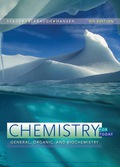
Chemistry for Today: General Organic and Biochemistry
9th Edition
ISBN: 9781337514576
Author: Seager
Publisher: Cengage
expand_more
expand_more
format_list_bulleted
Concept explainers
Textbook Question
Chapter 9, Problem 9.3E
Each of the following produces a basic solution when dissolved in water. Identify those that behave as Arrhenius bases and write dissociation equations to illustrate that behavior.
a.
b.
c.
d.
Expert Solution & Answer
Trending nowThis is a popular solution!

Students have asked these similar questions
Hello, I need help with my pre-lab! We are doing a buffer solution in lab for tomorrow and were assigned 3 pH values to create. Mine were pH= 4.50 7.80 9.90
We have to perform, 1 Titration buffer, 1 solid/solution buffer, and 1 solution/solution buffer. I need help with finding out which acids to use, how much, which base to use and how much.
A chemical engineer is studying the two reactions shown in the table below.
In each case, she fills a reaction vessel with some mixture of the reactants and products at a constant temperature of 70.0 °C and constant total pressure.
Then, she measures the reaction enthalpy AH and reaction entropy AS of the first reaction, and the reaction enthalpy AH and reaction free energy AG of the
second reaction. The results of her measurements are shown in the table.
Complete the table. That is, calculate AG for the first reaction and AS for the second. (Round your answer to zero decimal places.) Then, decide whether, under
the conditions the engineer has set up, the reaction is spontaneous, the reverse reaction is spontaneous, or neither forward nor reverse reaction is spontaneous
because the system is at equilibrium.
-
P₁ (s) + 20HF (g). 4PF, (g) + 10H2(g)
AH-1005. kJ
J
AS 2929.
K
AG =
0 kJ
Which is spontaneous?
this reaction
the reverse reaction
neither
AH = 12. kJ
+0=
AS =
SnO2 (s) + 2CO(g) →…
A chemist fills a reaction vessel with 0.281 g silver chromate (Ag₂CrO4) solid, 0.710 M silver (Ag*) aqueous solution, and 0.985 M chromate (CrO2-)
aqueous solution at a temperature of 25.0°C.
Under these conditions, calculate the reaction free energy AG for the following chemical reaction:
Ag2CrO4(s) 2Ag(aq) + CrO4(aq)
Use the thermodynamic information in the ALEKS Data tab. Round your answer to the nearest kilojoule.
4
☐ kJ
x
Chapter 9 Solutions
Chemistry for Today: General Organic and Biochemistry
Ch. 9 - Write the dissociation equations for the following...Ch. 9 - Write the dissociation equations for the following...Ch. 9 - Each of the following produces a basic solution...Ch. 9 - Prob. 9.4ECh. 9 - Identify each Brnsted acid and base in the...Ch. 9 - Prob. 9.6ECh. 9 - Prob. 9.7ECh. 9 - Prob. 9.8ECh. 9 - Prob. 9.9ECh. 9 - Write equations to represent the Brnsted acid...
Ch. 9 - Write a formula for the conjugate base formed when...Ch. 9 - Write a formula for the conjugate base formed when...Ch. 9 - Prob. 9.13ECh. 9 - Prob. 9.14ECh. 9 - The following reactions illustrate Brnsted...Ch. 9 - Prob. 9.16ECh. 9 - Write equations to illustrate the acid-base...Ch. 9 - Prob. 9.18ECh. 9 - Prob. 9.19ECh. 9 - Prob. 9.20ECh. 9 - Prob. 9.21ECh. 9 - Prob. 9.22ECh. 9 - The acid H3C6H5O7 forms the citrate ion, C6H5O73,...Ch. 9 - The acid H2C4H4O4 forms the succinate ion,...Ch. 9 - Prob. 9.25ECh. 9 - Prob. 9.26ECh. 9 - Calculate the molar concentration of OH in water...Ch. 9 - Calculate the molar concentration of OH in water...Ch. 9 - Calculate the molar concentration of H3O+ in water...Ch. 9 - Prob. 9.30ECh. 9 - Classify the solutions represented in Exercises...Ch. 9 - Classify the solutions represented in Exercises...Ch. 9 - Prob. 9.33ECh. 9 - Prob. 9.34ECh. 9 - Determine the pH of water solutions with the...Ch. 9 - Prob. 9.36ECh. 9 - Prob. 9.37ECh. 9 - Determine the pH of water solutions with the...Ch. 9 - Determine the [H+] value for solutions with the...Ch. 9 - Determine the [H+] value for solutions with the...Ch. 9 - Prob. 9.41ECh. 9 - Prob. 9.42ECh. 9 - The pH values listed in Table 9.1 are generally...Ch. 9 - Prob. 9.44ECh. 9 - Prob. 9.45ECh. 9 - Prob. 9.46ECh. 9 - Prob. 9.47ECh. 9 - Using the information in Table 9.4, describe how...Ch. 9 - Write balanced molecular equations to illustrate...Ch. 9 - Write balanced molecular equations to illustrate...Ch. 9 - Prob. 9.51ECh. 9 - Prob. 9.52ECh. 9 - Prob. 9.53ECh. 9 - Prob. 9.54ECh. 9 - Write balanced molecular, total ionic, and net...Ch. 9 - Prob. 9.56ECh. 9 - Prob. 9.57ECh. 9 - Prob. 9.58ECh. 9 - Prob. 9.59ECh. 9 - Prob. 9.60ECh. 9 - Prob. 9.61ECh. 9 - Prob. 9.62ECh. 9 - Prob. 9.63ECh. 9 - Prob. 9.64ECh. 9 - Prob. 9.65ECh. 9 - Prob. 9.66ECh. 9 - Prob. 9.67ECh. 9 - Prob. 9.68ECh. 9 - Prob. 9.69ECh. 9 - Prob. 9.70ECh. 9 - Determine the number of moles of each of the...Ch. 9 - Prob. 9.72ECh. 9 - Prob. 9.73ECh. 9 - Determine the number of equivalents and...Ch. 9 - Determine the number of equivalents and...Ch. 9 - Prob. 9.76ECh. 9 - Prob. 9.77ECh. 9 - Prob. 9.78ECh. 9 - Prob. 9.79ECh. 9 - The Ka values have been determined for four acids...Ch. 9 - Prob. 9.81ECh. 9 - Prob. 9.82ECh. 9 - Prob. 9.83ECh. 9 - Prob. 9.84ECh. 9 - Prob. 9.85ECh. 9 - Prob. 9.86ECh. 9 - Arsenic acid (H3AsO4) is a moderately weak...Ch. 9 - Explain the purpose of doing a titration.Ch. 9 - Prob. 9.89ECh. 9 - Prob. 9.90ECh. 9 - Prob. 9.91ECh. 9 - Prob. 9.92ECh. 9 - Prob. 9.93ECh. 9 - Prob. 9.94ECh. 9 - Prob. 9.95ECh. 9 - Prob. 9.96ECh. 9 - A 25.00-mL sample of gastric juice is titrated...Ch. 9 - A 25.00-mL sample of H2C2O4 solution required...Ch. 9 - Prob. 9.99ECh. 9 - Prob. 9.100ECh. 9 - The following acid solutions were titrated to the...Ch. 9 - The following acid solutions were titrated to the...Ch. 9 - Prob. 9.103ECh. 9 - Prob. 9.104ECh. 9 - Prob. 9.105ECh. 9 - Prob. 9.106ECh. 9 - Prob. 9.107ECh. 9 - Predict the relative pH greater than 7, less than...Ch. 9 - Prob. 9.109ECh. 9 - Explain why the hydrolysis of salts makes it...Ch. 9 - How would the pH values of equal molar solutions...Ch. 9 - Write equations similar to Equations 9.48 and 9.49...Ch. 9 - Prob. 9.113ECh. 9 - Prob. 9.114ECh. 9 - Prob. 9.115ECh. 9 - a.Calculate the pH of a buffer that is 0.1M in...Ch. 9 - Which of the following acids and its conjugate...Ch. 9 - Prob. 9.118ECh. 9 - Prob. 9.119ECh. 9 - What ratio concentrations of NaH2PO4 and Na2HPO4...Ch. 9 - Prob. 9.121ECh. 9 - Prob. 9.122ECh. 9 - Prob. 9.123ECh. 9 - Prob. 9.124ECh. 9 - Prob. 9.125ECh. 9 - Prob. 9.126ECh. 9 - Prob. 9.127ECh. 9 - Prob. 9.128ECh. 9 - Prob. 9.129ECh. 9 - Bottles of ketchup are routinely left on the...Ch. 9 - Prob. 9.131ECh. 9 - Prob. 9.132ECh. 9 - Prob. 9.133ECh. 9 - Prob. 9.134ECh. 9 - Prob. 9.135ECh. 9 - Prob. 9.136ECh. 9 - Prob. 9.137ECh. 9 - A base is a substance that dissociates in water...Ch. 9 - Prob. 9.139ECh. 9 - Prob. 9.140ECh. 9 - What is the formula of the hydronium ion? a.H+...Ch. 9 - Which of the following substances has a pH closest...Ch. 9 - Dissolving H2SO4 in water creates an acid solution...Ch. 9 - Prob. 9.144ECh. 9 - A common detergent has a pH of 11.0, so the...Ch. 9 - Prob. 9.146ECh. 9 - The pH of a blood sample is 7.40 at room...Ch. 9 - Prob. 9.148ECh. 9 - Prob. 9.149ECh. 9 - Prob. 9.150ECh. 9 - Prob. 9.151ECh. 9 - Which of the following compounds would be...Ch. 9 - A substance that functions to prevent rapid,...Ch. 9 - Which one of the following equations represents...Ch. 9 - Which reaction below demonstrates a neutralization...Ch. 9 - In titration of 40.0mL of 0.20MNaOH with 0.4MHCl,...Ch. 9 - When titrating 50mL of 0.2MHCl, what quantity of...
Knowledge Booster
Learn more about
Need a deep-dive on the concept behind this application? Look no further. Learn more about this topic, chemistry and related others by exploring similar questions and additional content below.Similar questions
- Draw the structure corresponding to each IUPAC name. Part 1 of 2 A skeletal structure corresponding to the IUPAC name 3-ethylhexane. Click and drag to start drawing a structure.arrow_forwardUsing any data you can find in the ALEKS Data resource, calculate the equilibrium constant K at 25.0 °C for the following reaction. TiC₁₁(g) + 2H₂O(g) → TiO2 (s) + 4HCl (g) 4 Round your answer to 2 significant digits. K = ☐ x10 D Хarrow_forward: ☐ Х Draw an α amino acid with a hydroxyethyl (-CH2-CH2- OH) side chain. Draw the molecule as it would appear at physiological pH. Click and drag to start drawing a structure. 5 Parrow_forward
- Draw the product of the reaction shown below. Ignore inorganic byproducts. cat. H2SO4 HNO3 (1 equiv) Drawing Qarrow_forwardProvide the correct systematic name for the compound shown here.arrow_forwardUsing the appropriate bond energies, calculate the heat of reaction AH for the following reaction: H-H + CI-CI 2 H-CI You can find a table of bond energies by using the Data button on the ALEKS toolbar. Round your answer to the nearest kJ/mol. Note: For clarity, all lone pairs have been omitted from the molecular structures. ☐ kJ mol ค 000 Ar Barrow_forward
- Predict the hydrocarbon, of formula C6H10, needed to prepare the following geminal dibromide upon treatment with excess hydrobromic acid. Note: The shown product is the only regioisomer formed in this reaction. HBr H₂C. CH3arrow_forwarddraw the major product formed with the listed reagentsarrow_forwardPropose Williamson ether syntheses for the following compoundsarrow_forward
- Identify all functional groupsarrow_forwardA mixture of CaCO3 and MgC2O4 of unknown mass was heated in a 0.5 L closed rigid vessel to 900 degrees C.at 400C the following reaction occurs:MgC2O4 -> MgO (s) + CO (g) + CO2 (g)At 700C a second reaction occurs: CaCO3 -> CaO (s) + CO2 (g)The solid mass in the vessel was measured to be 3.06 g at 400C and 2.03g at 900CQuestion: What is the partial pressure of CO in both temperatures? (400 and 900C), provide detailed explanation.arrow_forwardFor the following alkyne, complete the reaction sequentially (that is draw the intermediate that we can’t stop at) and then name (complete name) all 3 molecules.arrow_forward
arrow_back_ios
SEE MORE QUESTIONS
arrow_forward_ios
Recommended textbooks for you
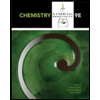 Chemistry & Chemical ReactivityChemistryISBN:9781133949640Author:John C. Kotz, Paul M. Treichel, John Townsend, David TreichelPublisher:Cengage Learning
Chemistry & Chemical ReactivityChemistryISBN:9781133949640Author:John C. Kotz, Paul M. Treichel, John Townsend, David TreichelPublisher:Cengage Learning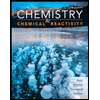 Chemistry & Chemical ReactivityChemistryISBN:9781337399074Author:John C. Kotz, Paul M. Treichel, John Townsend, David TreichelPublisher:Cengage Learning
Chemistry & Chemical ReactivityChemistryISBN:9781337399074Author:John C. Kotz, Paul M. Treichel, John Townsend, David TreichelPublisher:Cengage Learning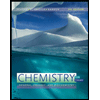 Chemistry for Today: General, Organic, and Bioche...ChemistryISBN:9781305960060Author:Spencer L. Seager, Michael R. Slabaugh, Maren S. HansenPublisher:Cengage Learning
Chemistry for Today: General, Organic, and Bioche...ChemistryISBN:9781305960060Author:Spencer L. Seager, Michael R. Slabaugh, Maren S. HansenPublisher:Cengage Learning ChemistryChemistryISBN:9781305957404Author:Steven S. Zumdahl, Susan A. Zumdahl, Donald J. DeCostePublisher:Cengage Learning
ChemistryChemistryISBN:9781305957404Author:Steven S. Zumdahl, Susan A. Zumdahl, Donald J. DeCostePublisher:Cengage Learning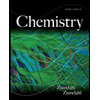

Chemistry & Chemical Reactivity
Chemistry
ISBN:9781133949640
Author:John C. Kotz, Paul M. Treichel, John Townsend, David Treichel
Publisher:Cengage Learning

Chemistry & Chemical Reactivity
Chemistry
ISBN:9781337399074
Author:John C. Kotz, Paul M. Treichel, John Townsend, David Treichel
Publisher:Cengage Learning

Chemistry for Today: General, Organic, and Bioche...
Chemistry
ISBN:9781305960060
Author:Spencer L. Seager, Michael R. Slabaugh, Maren S. Hansen
Publisher:Cengage Learning


Chemistry
Chemistry
ISBN:9781305957404
Author:Steven S. Zumdahl, Susan A. Zumdahl, Donald J. DeCoste
Publisher:Cengage Learning

General Chemistry | Acids & Bases; Author: Ninja Nerd;https://www.youtube.com/watch?v=AOr_5tbgfQ0;License: Standard YouTube License, CC-BY